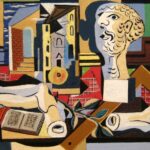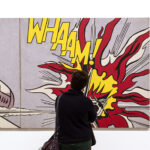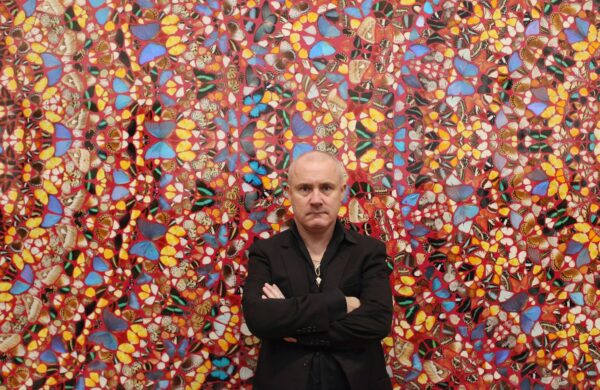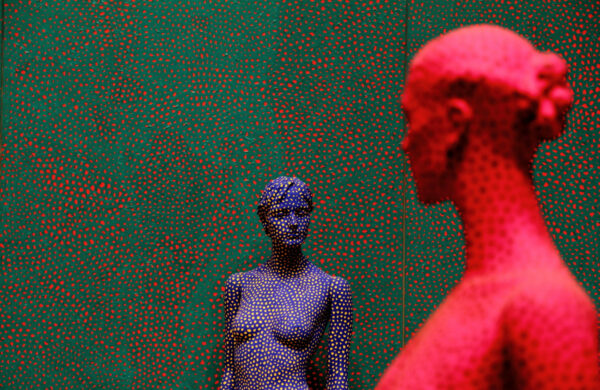Willem de Kooning: Life and Artistic Legacy
Willem de Kooning is celebrated as a top Dutch-American artist of the 20th century. He led the way in Abstract Expressionism. In doing so, he changed the face of modern art.
He was born in Rotterdam, the Netherlands, in 1904. Starting from a young age, he was inspired by van Gogh and Mondrian. This led him to create a style all his own.
When de Kooning was 22, he moved to the United States. This is where he truly found his place in the art world. He arrived just as Abstract Expressionism was becoming a major force.
His works were known for their boldness and energy. They were filled with bright colors and combined real and abstract forms. This made his art both powerful and unique.
Key Takeaways:
- Willem de Kooning was a leading Dutch-American artist associated with the Abstract Expressionism movement.
- His unique style defied conventions and showcased a blend of figurative and abstract elements.
- De Kooning’s bold brushwork and vibrant colors conveyed raw emotion in his artworks.
- He played a pivotal role in the rise of Abstract Expressionism and the development of modern art.
- Willem de Kooning’s legacy continues to influence and inspire artists today.
Early Life and Influences
 “Excavation” by Willem de Kooning
“Excavation” by Willem de Kooning
Willem de Kooning has a big part in making Abstract Expressionism what it is today. He drew from his early years and many overseas influences to craft his one-of-a-kind style.
He was born in 1904 in Rotterdam, a city in the Netherlands. His parents, Leendert de Kooning and Cornelia Nobel, had simple jobs. This put de Kooning in contact with art from a young age.
De Kooning started taking art classes at the Rotterdam Academy when he was young. Being taught about the Old Masters began to shape his own artistic vision.
He moved to the United States in 1926, looking for new chances. New York City’s flourishing art scene became his new home. This move marked a turning point in his career.
In the U.S., de Kooning was motivated by American greats like Arshile Gorky and Stuart Davis. The city’s buzz and artistic freedom significantly changed his work.
The bustle and life of New York also left a mark on de Kooning’s paintings. He mixed his own emotions with the city’s energy into his art. That blend gave birth to his unique abstract style.
De Kooning once said, “Flesh was the reason oil painting was invented.”
He valued the human form in art. This belief shows in the abstract yet human quality of his art.
Influence of Dutch Masters
De Kooning never forgot his Dutch roots. He admired painters like Rembrandt and Vermeer, which showed in his art’s use of light and detail. Mixing these traditions with American art’s boldness made his work stand out.
| Important Influences | Impact on De Kooning’s Art |
|---|---|
| The Dutch Masters | Influenced his approach to light, shadow, and detail |
| The American art scene | Provided inspiration and freedom for artistic experimentation |
| New York City | Contributed to the vibrant energy and urban influence in his work |
De Kooning’s growth and influences started a movement. Next, we’ll see how Abstract Expressionism took off and de Kooning’s big part in it.
The Rise of Abstract Expressionism
In the middle of the 20th century, a new art movement was born. It was called Abstract Expressionism. This art form was all about emotions and spontaneity. A key figure in this movement was Willem de Kooning, who was from the Netherlands but worked in America.
De Kooning was known for his unique style in abstract art. His goal was to show the human experience through big brushstrokes and bright colors. His paintings are full of life and emotion, drawing people in.
This art style was all about breaking the rules and showing your own voice. De Kooning mixed abstract and real-life elements in his work. This made his art stand out in the contemporary art world.
“Every so often, a painting has to fight for its life.” – Willem de Kooning
De Kooning was a game-changer in the art world. His work broke old rules and opened doors for new artists. Even today, artists around the world take inspiration from his bold approach.
The Influence of Willem de Kooning’s Abstract Expressionism
De Kooning’s art continues to shape modern art. He inspired artists everywhere to be bold and try new things. His legacy lives on through the works of those he influenced.
Abstract Expressionism, led by artists like de Kooning, is still important today. It has influenced how we think about and create art. De Kooning’s contributions are a key part of its history.
| Impact | Examples |
|---|---|
| Redefined artistic boundaries | Willem de Kooning’s “Woman I” challenged society’s perception of female representation in art, breaking traditional conventions. |
| Inspired future generations | Artists like Elizabeth Murray and Julian Schnabel drew inspiration from de Kooning’s innovative use of color and form. |
| Elevated the importance of emotion in art | De Kooning’s expressive brushwork and raw energy conveyed the power of emotion, influencing contemporary art practices. |
De Kooning’s Artistic Style and Techniques
Willem de Kooning was a famous Dutch-American artist known for his lively paintings. He made a big impact on modern and contemporary art. We will explore his unique style and methods. This includes his use of color, form, and composition in making his great works.
Color Palette and Expression
De Kooning used bold, vibrant colors in his paintings. He mixed colors that don’t usually go together, creating beautiful compositions. You’ll see bright pinks, blues, yellows, and greens in his art, which bring life and motion.
His special way of painting made his work look deep and textured. Colors weren’t just for showing what was there. They also stirred up feelings and reactions in people. This made his art very powerful and moving.
Dynamic Forms and Gestures
De Kooning’s work showed his strong brushwork and understanding of shape. He liked to paint figures, nature, and objects in a wild, abstract way. This made his paintings burst with energy and feelings, not just a copy of real life.
His brushstrokes showed a lot of movement and life. This made his art feel alive, letting people feel the strong emotions in his paintings.
Innovative Composition and Subject Matter
De Kooning tried new ways to set up his paintings, changing the old rules of art. He mixed different views and sometimes cut up his canvas. This added excitement and depth to what he painted.
He painted all kinds of things, from women in abstract forms to scenes of the city. This gave his work a rich variety. People could see many different things in his art, from people to places, all full of energy and change.
| Characteristic | Description |
|---|---|
| Color Palette | Bold, vibrant, and unconventional combinations |
| Brushwork and Layering Techniques | Creating depth and texture through skillful brushwork |
| Dynamic Forms and Gestures | Abstract and distorted forms conveying movement and vitality |
| Innovative Composition | Challenging traditional norms with fragmented perspectives |
| Diverse Subject Matter | Including abstract representations of women, landscapes, and urban settings |
Influence and Legacy
 De Kooning – Decades – Sotheby’s
De Kooning – Decades – Sotheby’s
Willem de Kooning was a major player in the art scene. He shaped Abstract Expressionism and pushed art forward. His influence is clearly seen in modern and contemporary art today.
De Kooning’s art changed the game by breaking old rules. He used rich colors, bold brushstrokes, and free movements. These elements grabbed people’s attention and amazed future artists.
“Art never seems to make me peaceful or pure. I always seem to be wrapped in the melodrama of vulgarity.” – Willem de Kooning
He was a master at showing emotions and energy in his paintings. De Kooning’s works were deep and vibrant, moving everyone who saw them. His paintings spoke to the soul.
Part of the Abstract Expressionism movement, de Kooning was at the forefront. Alongside greats like Jackson Pollock and Mark Rothko, he laid the foundation for modern art. This movement is now a key part of art history.
Inspiring Future Generations
De Kooning didn’t just inspire his peers; his impact continues to shape art today. Many artists have found new paths because of him. He encouraged them to be fearless and original.
The way de Kooning painted urged artists to be daring. He believed in going against the norm and finding their own style. This has echoed through the years in many artists’ works.
The influence of de Kooning goes on, warming our hearts in the current art world. His vision and daring spirit live in artists worldwide. He pushed the art world forward, and we still feel his effect today.
| Willem de Kooning: Influence and Legacy |
|---|
| – Inspiring future generations of artists through his bold and innovative style |
| – Challenging artistic conventions and pushing the boundaries of abstract art |
| – Contributing to the development of Abstract Expressionism and its lasting impact on modern and contemporary art |
| – Leaving a lasting legacy as an influential artist whose work continues to resonate with audiences worldwide |
Conclusion
We learned about Willem de Kooning’s life and art in this article. He was a famous Dutch-American artist. His work really helped Abstract Expressionism and Modern art grow. He moved from the Netherlands to the United States, and that journey influenced his art a lot.
De Kooning was a big part of Abstract Expressionism. His paintings were bold and full of energy. He used color and shape to show a lot of movement. This made his art feel very alive and caught the emotions of people.
De Kooning’s art still matters a lot in today’s art world. It changed how future artists would paint. He inspired many to try new things in art. De Kooning’s work makes people feel deeply when they look at it.
FAQ
Who is Willem de Kooning?
Willem de Kooning was a Dutch-American artist. He is famous for making modern art. Born in Rotterdam in 1904, he moved to the U.S. As a key figure, his work changed the art world.
What is Abstract Expressionism?
Abstract Expressionism began in the U.S. in the 1940s and 1950s. It uses shapes and movements to show feelings. De Kooning was important in this, making big, free paintings.
How did Willem de Kooning influence modern art?
De Kooning changed art by mixing abstract and real. His big, bold paintings showed new ways to paint. His work in Abstract Expressionism grew the movement.
What are some of Willem de Kooning’s famous paintings?
Famous works by de Kooning include “Woman I,” “Excavation,” “Marilyn Monroe,” and “Untitled VI.” They show his lively style. His art uses bright colors and strong motions.
What is Willem de Kooning’s artistic legacy?
De Kooning’s legacy in art is strong. His way of painting still influences artists today. His impact on art is big and his work is still loved for its courage and emotion.
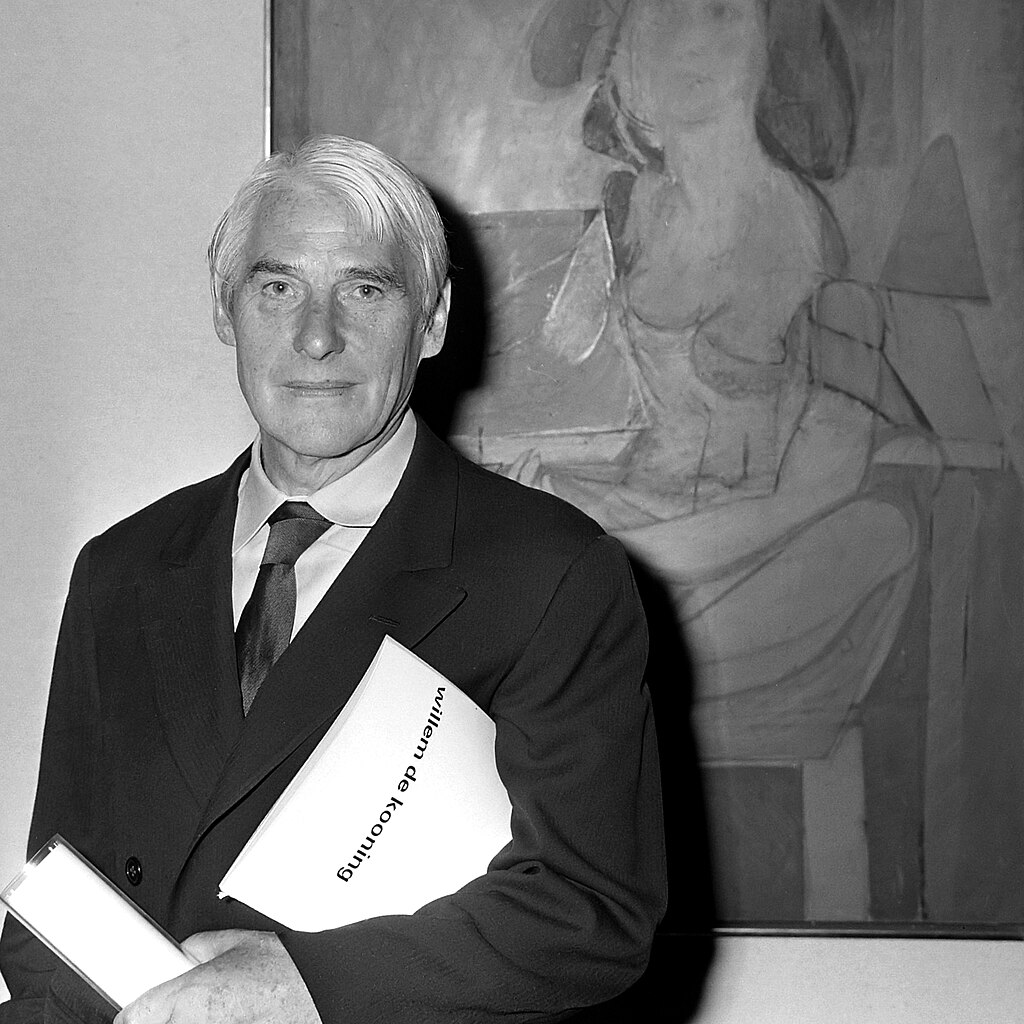
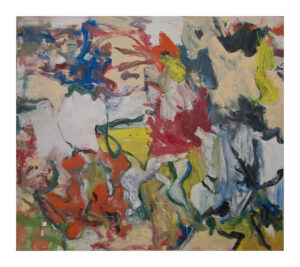 De Kooning – ph Martin Beek
De Kooning – ph Martin Beek 